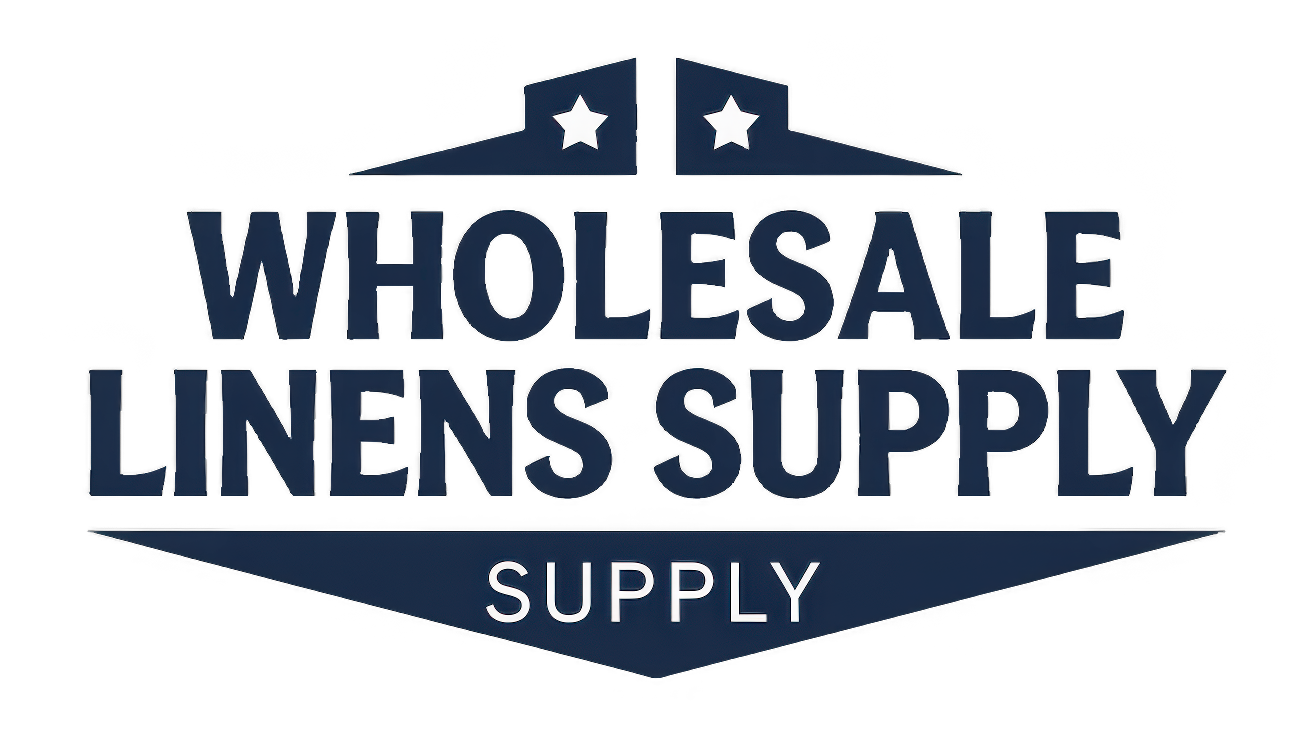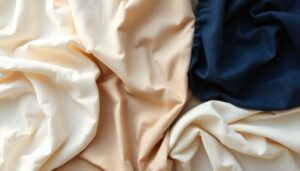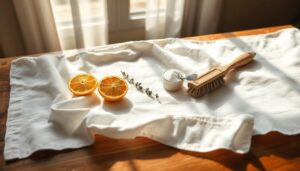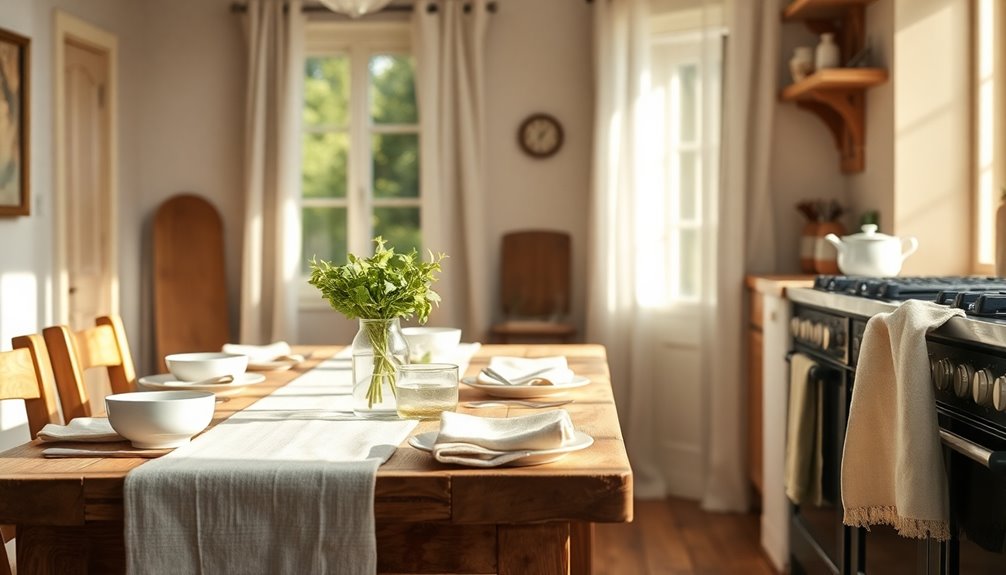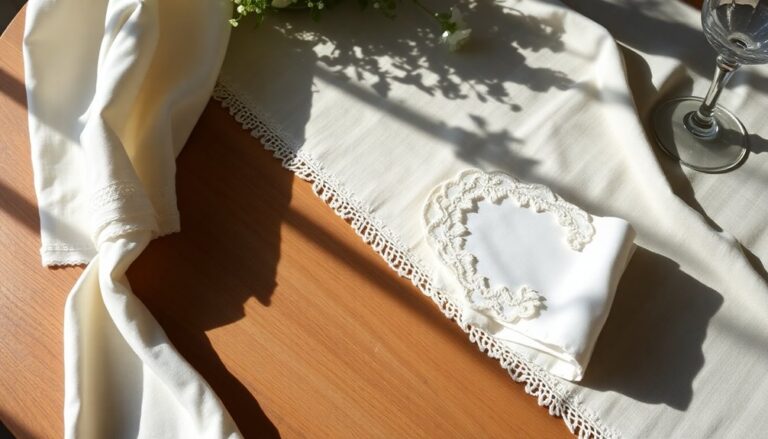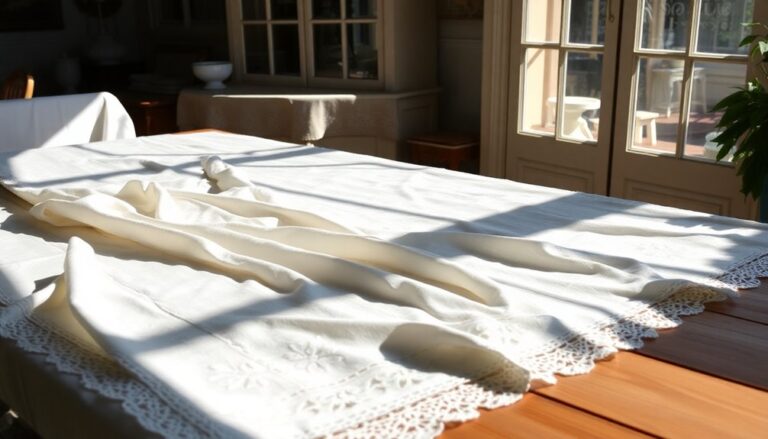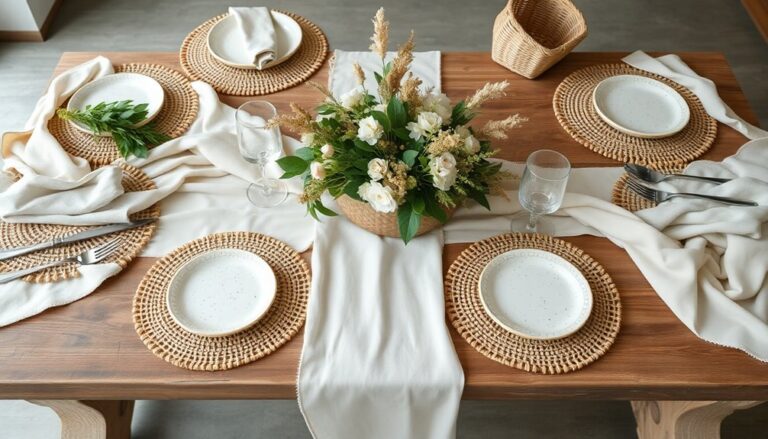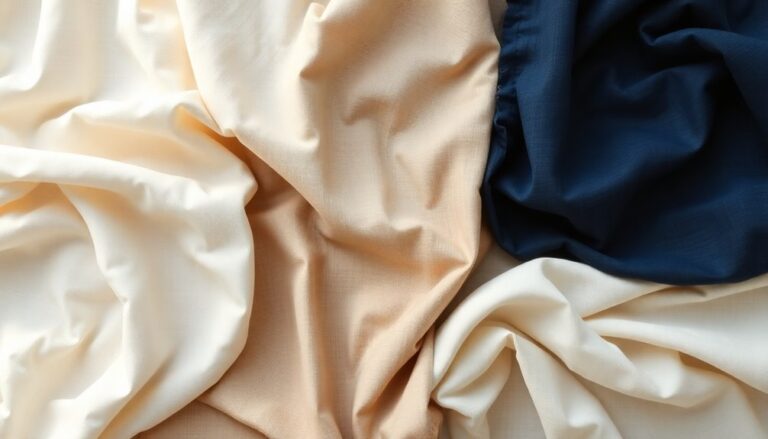Linen's benefits in the kitchen are impressive. It's naturally durable, resisting fraying and tearing as it becomes softer with use. Linen's high heat resistance allows safe handling of hot cookware, making it perfect for oven mitts and pot holders. Its moisture-wicking properties help maintain a dry environment, whereas ease of care guarantees it stays fresh with minimal maintenance. Plus, being eco-friendly, linen supports sustainability. For those curious about more advantages, there are even more surprises to discover.
Article Highlights
- Linen kitchen textiles are highly durable, resisting fraying and tearing, which ensures they last longer than many other fabrics.
- The fabric's natural heat resistance allows safe handling of hot cookware, protecting both hands and surfaces.
- Linen's moisture-wicking properties keep users comfortable and promote a dry working environment during cooking.
- Easy to care for, linen textiles are machine washable and naturally stain-resistant, simplifying maintenance in busy kitchens.
- Being eco-friendly, linen is biodegradable, requires less water to produce, and supports sustainable practices.
Natural Durability and Longevity
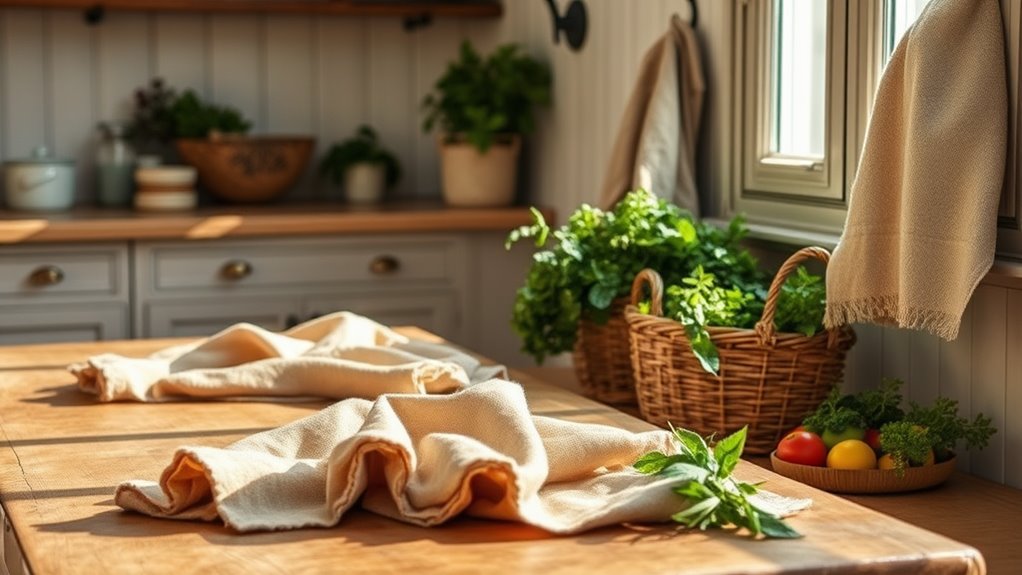
Although many fabrics wear out quickly, linen stands out for its remarkable durability and longevity. Made from strong linen fibers, this natural material can withstand the rigors of daily use, making it an excellent choice for kitchen textiles. Unlike cotton or synthetic options, linen doesn't easily fray or tear, ensuring that items like dish towels and tablecloths last much longer. Its inherent strength means it's able to handle spills and stains with ease, often becoming softer and more absorbent over time. This durability not only saves money in the long run but also contributes to a more sustainable lifestyle. Therefore, incorporating linen into kitchen textiles is a smart decision for anyone seeking quality and reliability in their home.
High Heat Resistance
Since kitchens are often filled with hot surfaces and steaming pots, the high heat resistance of linen makes it an ideal choice for various kitchen applications. Linen's natural fibers provide excellent heat insulation, protecting hands and surfaces from burns during handling hot cookware. This quality improves cooking safety, as it allows cooks to work with confidence around high temperatures. Unlike some synthetic materials, linen doesn't melt or warp when exposed to heat, making it a reliable option for oven mitts, pot holders, and table linens. Furthermore, its durability guarantees that these items can withstand regular use without compromising their protective qualities. Embracing linen in the kitchen not just enhances aesthetics but contributes to a safer cooking environment.
Moisture-Wicking Properties
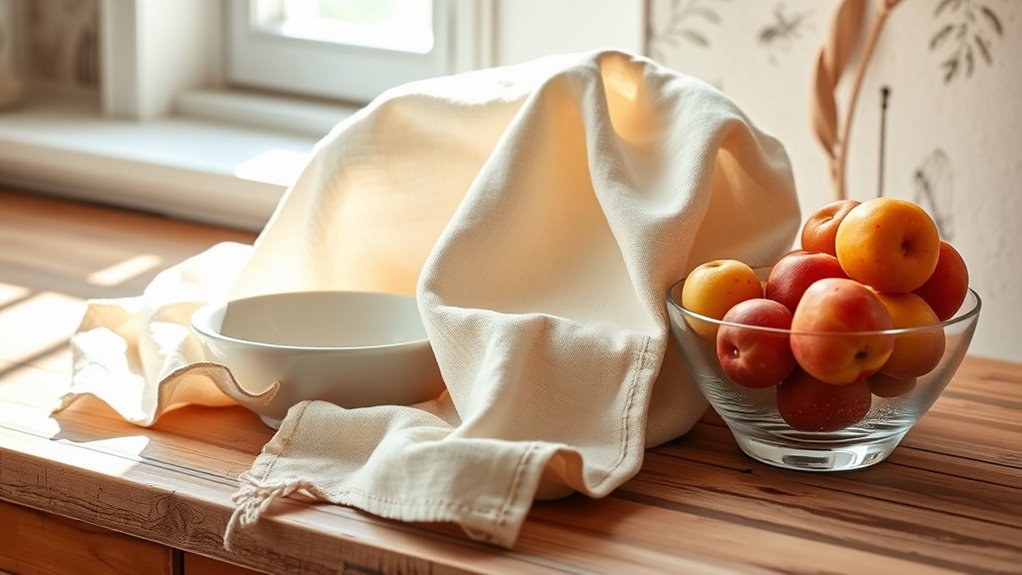
In addition to its high heat resistance, linen additionally boasts impressive moisture-wicking properties, making it a versatile choice for the kitchen. This natural fabric surpasses in moisture absorption, drawing sweat and spills away from the skin, which keeps the user comfortable during cooking. The inherent fabric breathability of linen allows air to circulate, preventing the buildup of dampness and ensuring a dry working environment.
| Property | Linen | Other Fabrics |
|---|---|---|
| Moisture Absorption | Excellent | Variable |
| Fabric Breathability | High | Low to Medium |
| Drying Time | Quick | Slower |
These qualities not only improve comfort but also contribute to a cleaner, more efficient kitchen experience.
Easy to Care For
One of the standout features of linen is how easy it is to care for, making it an ideal choice for busy kitchens. Linen's natural stain resistance helps keep spills at bay, allowing it to maintain a fresh appearance even with frequent use. When accidents happen, most stains can be treated easily, ensuring that kitchen linens stay looking their best. Furthermore, easy laundering means that washing linen items is a breeze; they can be tossed into the washing machine without worry. Unlike some fabrics that require special care, linen's durability allows it to withstand regular cleaning. This combination of stain resistance and simple maintenance makes linen a practical and attractive option for anyone looking to simplify their kitchen chores.
Eco-Friendly Choice
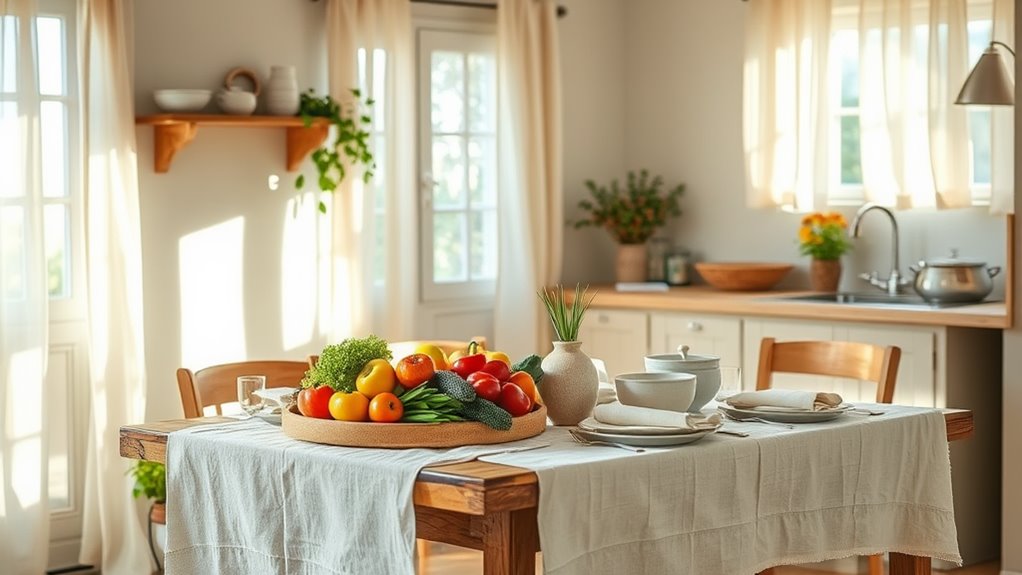
In regard to eco-friendly options in the kitchen, linen stands out as a sustainable choice. Its material is sourced responsibly, and it's both biodegradable and compostable, making it a smart alternative to synthetic fabrics. By choosing linen, individuals can reduce their environmental impact as they enjoy durable kitchen textiles.
Sustainable Material Sourcing
Although many materials contribute to environmental harm, linen stands out as a sustainable choice for kitchen textiles. Its eco-friendly benefits aren't just about appearance; they originate from responsible linen sourcing and sustainable production practices.
- Low Water Usage: Linen requires considerably less water compared to cotton, making it a more sustainable option.
- Pesticide-Free: Flax, the plant used for linen, grows naturally and often doesn't need chemical pesticides.
- Durability: Linen textiles last longer, reducing waste and the need for frequent replacements.
- Local Sourcing: Linen can often be sourced locally, minimizing transportation emissions and supporting local economies.
Choosing linen is not just about aesthetics; it's a commitment to a greener kitchen and a healthier planet.
Biodegradable and Compostable
Linen's natural composition makes it an excellent choice for those seeking biodegradable and compostable kitchen textiles. Unlike synthetic fabrics, linen is made from flax, a plant that breaks down easily in the environment. When kitchen linens made from biodegradable materials are disposed of, they can decompose without harming the planet. This offers significant compost benefits, enriching the soil instead of adding to landfill waste. By choosing linen, individuals contribute to a more sustainable lifestyle, reducing their carbon footprint and promoting eco-friendly practices. Furthermore, as linen textiles return to the earth, they help close the loop in the lifecycle of materials, allowing consumers to feel good about their choices and their impact on the environment.
Timeless Aesthetic Appeal
The effortless elegance of linen brings a timeless aesthetic appeal to any kitchen. Its elegant texture and classic colors create a welcoming atmosphere that never goes out of style. Linen's versatility allows it to complement various design themes, making it a favorite for many homeowners. Here are some of its standout qualities:
- Natural Look: Linen's organic fibers provide a warm, inviting feel.
- Durability: It withstands daily use as it maintains its beauty.
- Versatile Designs: Available in a range of patterns and shades, it fits any décor.
- Easy to Care For: Linen becomes softer with each wash, improving its appeal over time.
Incorporating linen into a kitchen not merely improves aesthetics but also raises the overall cooking experience.
Frequently Asked Questions
Can Linen Be Used for Tablecloths and Napkins?
As the sun sets, casting a warm glow, the dinner table awaits its elegant transformation. Can linen be used for tablecloths and napkins? Absolutely! Linen's natural charm makes it a top choice among tablecloth options, effortlessly improving any dining experience. Plus, its breathability and absorbency bring napkin benefits that augment both practicality and style. Guests can enjoy a touch of sophistication as they savor their meal, creating memories that linger long after the last bite.
How Does Linen Compare to Cotton in the Kitchen?
When comparing linen to cotton in the kitchen, durability plays a significant role. Linen's fibers are stronger, allowing it to withstand wear and tear better than cotton. Furthermore, linen surpasses in moisture management, absorbing moisture as it dries quickly, which helps maintain a fresh environment. Cotton, although soft and absorbent, can struggle with drying, leading to potential mildew. Overall, linen offers superior durability and moisture management, making it a reliable choice for kitchen textiles.
Is Linen Safe for Food Contact?
In a world where fabrics dance like leaves in the breeze, linen stands as a trusted guardian of food safety. It's often deemed food grade, ensuring that it won't release harmful chemicals during contact. Linen safety is paramount, especially in kitchens where nourishment is crafted. With its breathable fibers, it naturally resists bacteria, making it a wise choice for culinary adventures. Consequently, one can savor the peace of mind linen provides in food preparation.
What Colors and Patterns Are Available in Linen Kitchen Textiles?
In terms of linen kitchen textiles, there's an impressive range of color varieties and pattern choices available. From classic whites and soft pastels to lively hues like deep blues and rich reds, options cater to diverse tastes. Moreover, patterns can range from simple stripes and checks to intricate florals and modern geometric designs. This versatility allows anyone to find the perfect linen that complements their kitchen decor as well as adding a touch of style.
How Does Linen Absorb Odors Compared to Other Fabrics?
When Sarah hosted a dinner party, she noticed how her cotton tablecloth retained the smell of garlic long after the meal. In a fabric comparison, linen stands out for its lower odor retention. Unlike cotton, which can absorb and hold onto scents, linen's natural fibers allow for better breathability and moisture wicking. This quality makes linen less likely to trap odors, ensuring a fresher atmosphere in her kitchen, even after cooking pungent dishes.
